By Vince Giuliano
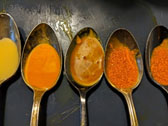

Frequent
Frequent readers of this blog know that I have invented a dietary supplement for the control of chronic inflammation, an important hallmark of aging disabilities. The purpose of this blog entry is bring together the vital information and research about this supplement, 4 Herb Synergy, in one place. In this blog entry, first I summarize the scientific basis for that invention. Then I recap the events that led to the creation of the invention, why my colleagues and I brought it to the marketplace, and some of the experience we have had to date in improving the product.
This blog entry summarizes, updates and extends the information provided in two earlier entries: INFLAMMATION PART 6: THE SCIENCE BEHIND THE 4 HERB SYNERGY DIETARY SUPPLEMENT, and On the Making of a Dietary Supplement.,
SECTION I: SUMMARY OF MAIN POINTS
Here are the main points of this blog entry. Literature citations and discussions that validate these points are included in SECTION II.
- THE SCIENTIFIC BASIS FOR 4-HERBS SYNERGY
The main points are:
Levels of chronic inflammation in humans increase with aging.
- Increase in chronic inflammation with aging “INFLAMMAGING” increases probabilities of multiple disease processes. Image source
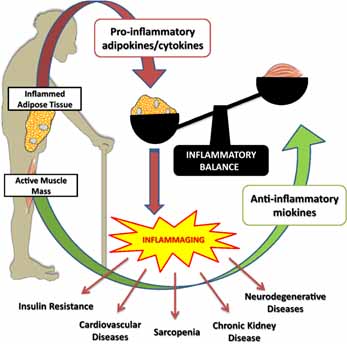
- Control of chronic inflammation is a key requirement for healthy aging and longevity.
- A central traditional approach to control of chronic inflammation, going back thousands of years, is the consumption of certain anti-inflammatory herbs.
- The biochemical constituents that control inflammation in those herbs are well-understood and are available in highly concentrated standardized forms.
- These different biochemical constituents act to control inflammation by diverse mechanisms.
- 4 Herb Synergy is a carefully engineered product designed to control chronic inflammation via a number of pathways that can operate synergistically.
- A problem with consuming some of those most important standardized anti-inflammatory herbal constituents is extremely poor bioavailability, inability of ingested substances to travel in the body and be absorbed where they are needed.
- Limited bioavailability and absorption of such key herbal substances can be most effectively addressed by using contemporary technologies of nano-particle delivery. In particular encapsulation of ingredients in liposomes, is a well-understood technique used in making 4 Herb Synergy.
- THE ORIGIN AND HISTORY OF 4 HERB SYNERGY – a personal story
The original invention of 4 Herb Synergy was a step in a 47-year personal struggle to control my own chronic inflammation, originally of arthritic origin.
- Starting in my 20s, I was beset by aches, pains and stiffness in certain joints making sleep and some forms of movement uncomfortable. In 1972 (aged 32) I first sought to limit such inflammatory symptoms.
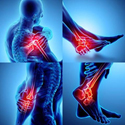 I got my advice back then by reading popular health articles in magazines and, once in a great while, from consulting with an alternative health practitioner. The first step was to limit my coffee consumption, which then was up to 6-8 cups a day. That worked and the symptoms went completely away for about 10 years. Image source
I got my advice back then by reading popular health articles in magazines and, once in a great while, from consulting with an alternative health practitioner. The first step was to limit my coffee consumption, which then was up to 6-8 cups a day. That worked and the symptoms went completely away for about 10 years. Image source - And then the inflammatory pains gradually returned. In 1982 (aged 42) had read some of Linus Pauling’s early works and started taking large doses of Vitamin C. This worked and the pains went away again for about 15 more years.
- Then I got a worse-than-ever attack of arthritic pains in 1997 (age 67). I found and read several books on the use of herbal medicines to treat arthritis. That was before much could be found on the subject on Internet. I came up with a dietary supplement regimen which I have continued to modify and improve ever since. Central to this regimen, in addition to the usual suspects like fish oils and vitamin C and D, were four herbs of Ayurvedic origin that were also each touted by book authors to be powerful anti-inflammatories that could just by themselves control RA symptoms – Curcumin, Ginger, Ashwagandha and Boswellia. These raw ingredients were all readily available in pill form as dietary supplements, so I decided to take them all. After taking this pill regimen for about 3 months my arthritic symptoms all but vanished again.
- I give a lot of credit to this supplement regimen for keeping me agile for my age and largely free of inflammatory aches and pains for some 16 more years, until about 2013, when I was 83. The knuckle joint in the small finger in my left hand, my usual early inflammation alarm indicator, was starting to act up again. When arthritic symptoms were starting, it would become stiff and click when I I worked it, a situation known as “trigger finger,”. By then I knew a lot more about the longevity sciences and about these herbs, and so I set about in the next step in my campaign to remain free of inflammatory aches, and pains and immobility. My conjecture, which turned out to be correct, was that the 4 herb combination I was taking was an excellent one for controlling systemic inflammation, but that not enough of these substances were getting into my body tissues where they were needed to do that job effectively. I needed to up the absorbability of the ingredients.
- That is when I developed the first formulation of 4 Herb Synergy in my kitchen, a liposomal version of the same combination of 4 herbs. At first, I thought I was pursuing a temporary personal health and longevity hack. (In fact, I have been consuming the latest versions of it daily ever since as a central part of my personal longevity campaign.) At the time, I knew I was growing older and increasingly vulnerable to the infirmities of old age. As a dedicated longevity science researcher, I also knew that my continuing wellbeing and energy level depended on control of systemic inflammation. I had already learned about the powerful anti-inflammatory impacts of certain key herbal chemical components in the four herbs. I had the pill-form experience with the 4 herbs. I knew how these could be combined for synergistic impact. And I knew how poor absorbability of these herbal chemicals could be overcome using a high-technology process of encapsulating the components into liposomal nano-particles. And I knew how to make liposomal concoctions using mechanical sheer and ultrasound. So I did that.
- Making a new batch of the supplement every 2 weeks or so became a pattern and soon Melody my wife started taking it too.
 Back then we called our kitchen-made product lipomix. Our basic tools were a powerful high-sheer blender and an ultrasound tool cleaner unit. If I neglected to make or take lipomix, after a week or two, the inflammatory symptoms like the trigger finger would begin to creep back. Resuming taking the supplement would cause symptoms to vanish again. So I learned the supplement was working for me. As the months and then years rolled by, we knew the supplement gave us a certain vitality, and never wanted to stop. The kitchen hacking turned into a process of continuing improvement of both process and product, switching from raw herbs to more-concentrated herbal extracts and improving the liposomal formulation process.
Back then we called our kitchen-made product lipomix. Our basic tools were a powerful high-sheer blender and an ultrasound tool cleaner unit. If I neglected to make or take lipomix, after a week or two, the inflammatory symptoms like the trigger finger would begin to creep back. Resuming taking the supplement would cause symptoms to vanish again. So I learned the supplement was working for me. As the months and then years rolled by, we knew the supplement gave us a certain vitality, and never wanted to stop. The kitchen hacking turned into a process of continuing improvement of both process and product, switching from raw herbs to more-concentrated herbal extracts and improving the liposomal formulation process. 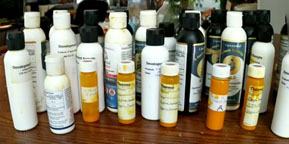 We did rounds of external laboratory testing to confirm liposomal content. Soon we were making batches for more and more friends and family members and this started to consume too much of our time and kitchen space.
We did rounds of external laboratory testing to confirm liposomal content. Soon we were making batches for more and more friends and family members and this started to consume too much of our time and kitchen space. - So, in 2017 we decided to make our liopmix into a commercial product which we renamed 4 Herb Synergy. And my family partners Mike and Melody and I set up our Synergy Bioherbls LLC and we went into business.
- To create 4 Herb Synergy as a marketable product, we have conducted two rounds of R&D together with our manufacturer partner – a small but highly reputable company owned by a biologist. The first was to develop our first generation Gold commercial product, and the second in 2020 to develop our second-generation Gold II product, Each round yielded significant Improvements in concentration, taste, added supporting anti-inflammatory ingredients, viscosity and shelf life. Gone are the quart sized bottles we used to fill up in our kitchen-hacking days, and our manufacturer is using a proprietary process which includes smaller liposomes in larger ones. And taste is significantly improved.
- Meanwhile, in the last six years I have focused much of my longevity research on understanding the cellular mechanisms of chronic inflammation, and you can read several articles I have written about this subject in my blog.
I tell the earlier part of this story in greater length in the blog entry On the Making of a Dietary Supplement.
MY BASIC MOTIVATION FOR SELLING A PRODUCT
In deciding to launch a dietary supplement business, the possibility of enhancing our family income was certainly a consideration. But it was not the most critical one. We have been living for a number of years on retirement income and could continue to do so. And at age 87 in 2017 why would I be willing to take on all the demands and hassles of going into a new business?
Perhaps the key consideration was that by creating a product I could likely do a lot more to enhance the health and longevity of people then simply by writing about it. Most of the content of this blog is highly technical and, unfortunately, not understandable by people who do not have a background in biology and molecular biology. This has frustrated me since my intention all along has been to enhance the healthy longevity of as many people as I could. But the menu is not a meal. And while I have said a great deal about the science of longevity, I had to acknowledge that few people could translate this into actions which would benefit themselves.
The question for me has been what can I do to actually help foster a transformation of society so that the average healthy fully active lifespan is increased by 20 or 30 years? After large number years of intensive study of the scientific topics related to longevity, I thought I understood how a reasonably healthy individual could do that starting now. Without waiting for further scientific breakthroughs or paying thousands to go to shady offshore longevity clinics. Part of my confidence in this understanding was knowing I have actually been doing that successfully for myself.
Thinking about it, I came to realize that the way our world works is that people benefit greatly from scientific knowledge and advanced technologies that are embodied in products, even though they do not begin to understand how or why those products work.
- Modern electronic devices and technologies like TV sets, computers and Internet are based on the electromagnetic series of Maxwell, and effects explainable only through the quantum physics of Max Planck, Niels Bohr, Dirac, Einstein and their colleagues. But ordinary people use these all them time without any understanding of how and why they work. Actually, it is quite miraculous how a tremendous cacophony of sounds, images and messages are constantly passing through the space around us without us sensing anything at all. But we do not have to think about that at all to use a cell phone or TV.
- The list of such science and technology-based products which we use and benefit from every day without understanding how they actually work goes on and on. Hundreds of millions of us enjoy relative immunity to the COVID19 pandemic because we are vaccinated. But only a tiny handful of us understand how and why the vaccines work. How many drivers of cars can characterize the operation of an internal combustion engine? How many people who flip a light switch understand the technology of electrical generation and transmission? How many users of microwave ovens can explain how they work? How many users of refrigerators and air conditioners can describe how they work? We don’t have to understand how a product works to get the benefits of the knowledge built into the product.
Realizing the above became fairly clear to me that I could possibly have a much bigger impact on longevity of others by packaging some of my most-central scientific knowledge into a product that people could easily buy. Users of the product could realize health and longevity benefits due to taking it, even if they did not understand how it works Around 2016 I realized that I actually had invented and was using such a product, our lipomix. And that I could create a commercial counterpart of it that I could sell. That, in a nutshell, has been my central motivation.
SECTION II – RESEARCH BACKUP
in this section I offer more detailed discussions and literature citations that are directly supportive of the main points in SECTION I.
- Scientific Basis for 4-Herb Synergy
- the aging process is characterized by chronic inflammation. Chronic inflammation is at the heart of multiple disease processes that emerge with advanced aging
I have generated multiple blog entries related to these facts, and they continues to be of central concern in the aging literature.
An example of the extensive literature on the subject is the 2020 publication Senoinflammation: A major mediator underlying age-related metabolic dysregulation. ”Chronic inflammation is a complex and unresolved inflammatory response with low-grade multivariable patterns that aggravate systemic pathophysiological conditions and the aging process. To redefine and delineate these age-related complex inflammatory phenomena at the molecular, cellular, and systemic levels, the concept of “Senoinflammation” was recently formulated. In this review, we describe the accumulated data on both the multiphase systemic inflammatory process and the cellular proinflammatory signaling pathway. We also describe the proinflammatory mechanisms underlying the metabolic molecular pathways in aging. Additionally, we review age-related lipid accumulation, the role of the inflammatory senescence-associated secretory phenotype (SASP), the involvement of cytokine/chemokine secretion, endoplasmic reticulum (ER) stress, insulin resistance, and autophagy. The last section of the review highlights the modulation of the senoinflammatory process by the anti-aging and anti-inflammatory action of calorie restriction (CR). Evidence from aging and CR research strongly suggests that SASP from senescent cells may be the major source of secreted cytokines and chemokines during aging. A better understanding of the mechanisms underpinning the senoinflammatory response and the mitigating role of CR will provide insights into the molecular mechanisms of chronic inflammation and aging for potential interventions.”
This diagram speaks to the role of chronic inflammation in various age-related disease processes:
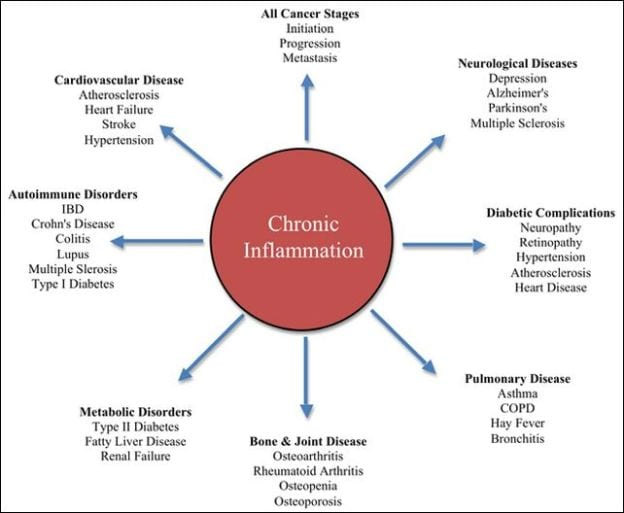
Again, inflammation itself is not the problem. Acute inflammation is an important natural body response necessary for wound healing. Without it, we would die. The problem with inflammaging addressed by our supplement is chronic inflammation – overall systemic inflammation that grows worse with aging. “Inflammation is actually the bodys normal response to conditions such as infection, toxins, and trauma.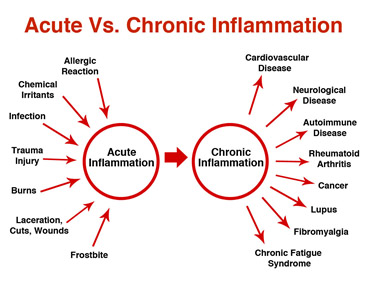
Under normal conditions, once the negative event is over, the body will produce an anti-inflammatory response to restore balance. In cases of chronic pain, however, the body is not able to regulate the inflammatory response. The result is chronic imbalance and chronic pain(ref).”
- Inflammatory cytokine levels in plasma increase with age in humans
This has been a theme frequently reiterated in this blog. As summarized in the 2010 publication Plasma Cytokine Levels in a Population-Based Study: Relation to Age and Ethnicity, “Background: Aging is one factor believed to contribute to processes that underlie chronic low-grade inflammation in older adults. Moreover, more recent studies have suggested that cytokine levels are influenced by ethnicity. Methods: In this study, we determined plasma cytokine profiles in a population-based sample (n = 1,411; aged 25–91 years) to determine the relationship between circulating cytokine levels, aging, and ethnicity. We measured interleukin-1 receptor antagonist (IL-1ra), interleukin (IL)-6, -10, C-reactive protein (CRP), and tumor necrosis factor-receptor 1 (TNF-r1). Results: IL-6 and TNF-r1 significantly increased with age, whereas IL-1ra, IL-10, and CRP did not significantly increase with age. After adjusting for age, non-Hispanic whites had significantly higher levels of IL-1ra than Mexican Americans, whereas non-Hispanic blacks had significantly higher levels of IL-6 and CRP than Mexican Americans as well as non-Hispanic whites. CRP levels in non-Hispanic blacks were no longer significantly higher after adjusting for body mass index (BMI), indicating that BMI is an important predictor of this inflammatory marker. Conclusions: These results demonstrate that cytokine levels are influenced by both age and ethnicity. Furthermore, these results show that inflammatory profiles for Mexican Americans are lower than non-Hispanic whites and non-Hispanic blacks.”
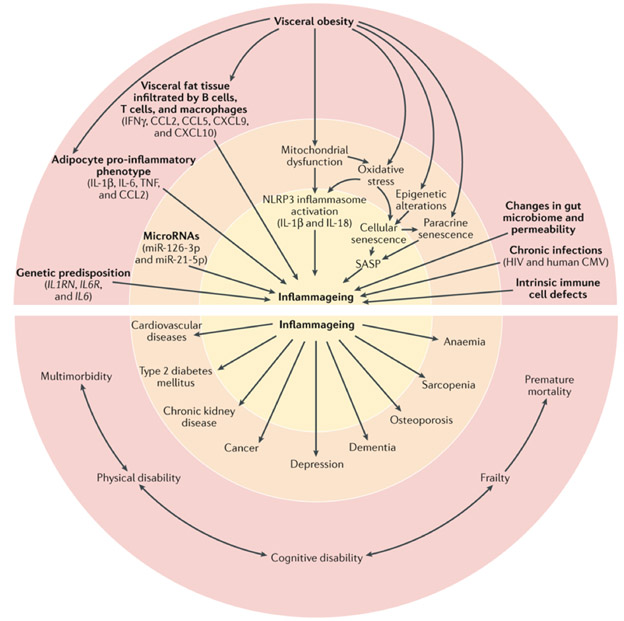
Image source Mikel Izquierdo
- The inflammaging hypothysis
This relationship between chronic inflammation and aging, often called the “inflammaging hypothysis” applies to numerous disease conditions. It is discussed in a large number of publications such as those in this list of Pubmed publictions. Steven Austad has offered a webinar on the subject accessible here. Webinar | Inflammation And Aging – Bing video.
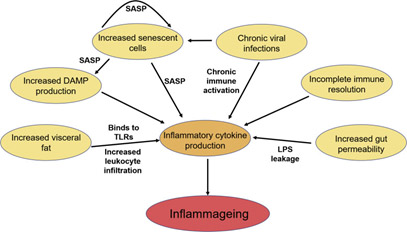
As an example, consider the relationship of aging and inflammation in cardiological diseases, a topic discussed in several recent publications including this 2020 one: Inflamm-ageing: the role of inflammation in age-dependent cardiovascular disease. “The ongoing worldwide increase in life expectancy portends a rising prevalence of age-related cardiovascular (CV) diseases in the coming decades that demands a deeper understanding of their molecular mechanisms. Inflammation has recently emerged as an important contributor for CV disease development. Indeed, a state of chronic sterile low-grade inflammation characterizes older organisms (also known as inflamm-ageing) and participates pivotally in the development of frailty, disability, and most chronic degenerative diseases including age-related CV and cerebrovascular afflictions. Due to chronic activation of inflammasomes and to reduced endogenous anti-inflammatory mechanisms, inflamm-ageing contributes to the activation of leucocytes, endothelial, and vascular smooth muscle cells, thus accelerating vascular ageing and atherosclerosis. Furthermore, inflamm-ageing promotes the development of catastrophic athero-thrombotic complications by enhancing platelet reactivity and predisposing to plaque rupture and erosion. Thus, inflamm-ageing and its contributors or molecular mediators might furnish targets for novel therapeutic strategies that could promote healthy ageing and conserve resources for health care systems worldwide. Here, we discuss recent findings in the pathophysiology of inflamm-ageing, the impact of these processes on the development of age-related CV diseases, results from clinical trials targeting its components and the potential implementation of these advances into daily clinical practice.”
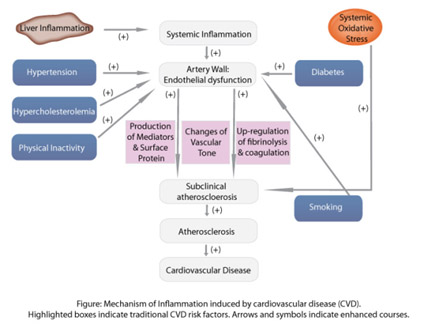
Other recent research publications relating inflammaging to cardiovascular disease risks are.
- Inflammation and cardiovascular diseases: lessons from seminal clinical trials (2021)
- Senescence-induced inflammation: an important player and key therapeutic target in atherosclerosis (2020)
- Targeting cardiovascular inflammation: next steps in clinical translation (2020)
- NLRP3 inflammasome as a key driver of vascular disease (2021)
A central traditional approach to control of chronic inflammation, going back thousands of years, is the consumption of certain anti-inflammatory herbs.
 Research studies asserting this can be found in the ancient Chinese and Aryuvedic literature. Modern scientific studies confirm the biological mechanisms and pathways through which herbal substances operate to control chronic inflammation(ref). This list contains many items in the current literature to this effect.
Research studies asserting this can be found in the ancient Chinese and Aryuvedic literature. Modern scientific studies confirm the biological mechanisms and pathways through which herbal substances operate to control chronic inflammation(ref). This list contains many items in the current literature to this effect.
The central mechanisms through which herbal substances can control inflammation are increasingly understood
These Include inhibition of expression of NF-kappaB, the central cellular mechanism for triggering inflammatory signaling, inhibition of formation and therefore inactivation of inflammasomes such as the NLRP3 inflammasome, deacetylation and therefore inactivation of pro-inflammatory genes, acetylation and therefore deactivation of anti-inflammatory genes, strong promotion of the NRF2 protein which activates hundreds of anti-inflammatory and “anti-oxidant response genes like heme oxygenase, suppression of histone methylation via JMJD3, selective gene and histone modifications which have anti-inflammatory impacts, activation of autophagy, cox-2 inhibition that directly targets cyclooxygenase-2, and inhibition of 5-lipoxygenase. Also, inhibition of other inflammatory pathways can be involved including JAK/STAT, AP-1, Hsp90, and HIF-1, and upgrading of tonic pathways such as PPARγ and Nrf2.
Over the years, I have written about most of these in this blog. A Google search combining any of these with anti-agingfirewalls.com should lead to what I have written. A search of the national library of medicine data base using the search terms inflammation and herbal medicine leads to the 1424 entries on this list.
Further, a great deal is known about what particular anti-inflammatory chemicals can be found in which herbs and how those chemicals work.
I confine my discussion here to brief discussions of the key anti-inflammatory chemicals known found in the four herbal ingredients in 4 Herb Synergy
- Curcuminoids, found in curcumin found in turmeric root. “Curcuminacts as an anti–inflammatory by inhibiting cyclooxygenase 2 (COX-2), inducible nitric oxide synthase (ins) and lipoxygenase (COX). INOs, LOX, and COX are key enzymes that mediate inflammatory(ref)” Further, curcumin inhibits the expression of NF-kb and pro-inflmmatory cytokines like TNF-alpha, (GM-CSF), IL-4, IL-5, and IL2 (ref). “Curcumin also reduces the expression of genes being regulated by NF-κB, including 5-lipoxygenase (5-LOX), tumor necrosis factor (TNF), adhesion molecules, interleukins (IL-1, IL-6, IL-8), chemokine receptor type 4 (CXCR-4), and C-reactive protein (Rao, 2007; Skommer et al., 2007)(ref).” Also, curcumin increases mitochondrial biogenesis and mitophagy(ref).
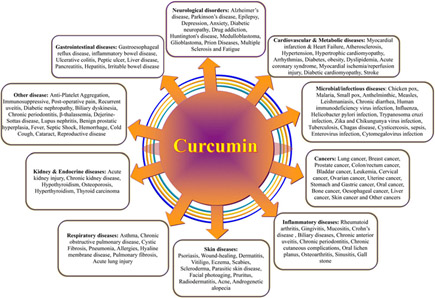
Image source: Cellular and molecular mechanisms of curcumin in prevention and treatment of disease
- Boswellic acid (AKBA), acetyl-11-keto-beta-boswellic acid (AKBA) found in the herb Boswellia. “Boswellic acids (BA), a natural mixture isolated from oleo gum resin of Boswellia serrata comprised of four major pentacyclic triterpene acids: b-boswellic acid (the most abundant), 3-acteyl-b-boswellic acid, 11-keto-b-boswellic acid, and 3-acetyl-11-keto-b-boswellic acid, is reported to be effective as anti-inflammatory, immunomodulatory, antitumor, anti-asthmatic and in Chron’s disease. It inhibits pro-inflammatory mediators in the body, specifically leukotrienes via inhibition of 5-lipoxygenase(ref).” “KBA and AKBA, have been shown to decrease production of proinflammatory cytokines including IL-1, IL-2, IL-6, IFN-γ and TNF-α which finally are directed to destroy tissues such as cartilage, insulin producing cells, bronchial, intestinal and other tissues. NFĸB is considered to be the target of AKBA.(ref)”
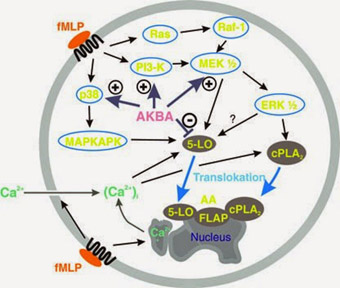
Image source, Illustrates the signaling cascade for the impact of AKBA on the 5-LOXIN inflammatory pathway
- Withanolides, found in the herb ashwagandha (Withania somnifera), also known as Indian ginseng). “In this chapter we identify and describe the major withanolides with anti-inflammatory properties, illustrate their role within essential and supportive inflammatory pathways (including NF-κB, JAK/STAT, AP-1, PPARγ, Hsp90 Nrf2, and HIF-1), and then discuss the clinical application of these withanolides in inflammation-mediated chronic diseases (including arthritis, autoimmune, cancer, neurodegenerative, and neurobehavioral)(ref)”
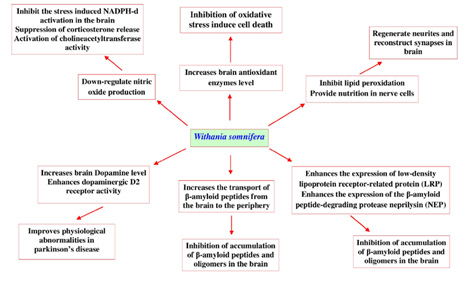
Image source Neuroprotective inpacts of withania somnifera (ashwagandha)
- Gingerols, found in ginger (Zingiber officinale Roscoe, Zingiberaceae). Gingerols can activate autophagy(ref), “The findings of this study demonstrate that S-[6]-gingerol protects HuH7 cells against IL1β-induced inflammatory insults through inhibition of the ROS/NFκB/COX2 pathway — Our findings show that S-[6]-gingerol protects HuH7 cells against an IL1β-induced inflammatory response by inhibiting the reactive-oxygen-species- (ROS-) activated NFκB/COX2 pathway. (ref).” “Gingerols inhibit the production of inflammatory mediators such as nitric oxide and Prostaglandin E2 (PGE2) in a dose-dependent manner(ref).50”
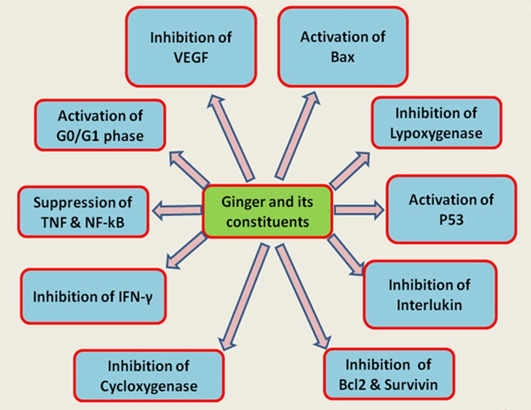
Image source Anti-inflammatory and other impacts of gingerols
The Synergy in 4 Herb Synergy
The synergy in 4 Herb Synergy exists because of the multiplicity of overlapping biological mechanisms against chronic information just listed in the previous section. 4 Herb Synergy is made out of the most-concentrated and highest quality available standardized herbal extracts of exactly the substances described just above, Curcuminoids, Boswellic acids (AKBA), Withanolides and Gingerols. Much of our high cost for manufacturing the product is associated with the relatively high costs of the standardized extracts.
The liposomal bodies in 4 Herb Synergy are more than just neutral carriers of the herbal extracts. Since they are made out of phosphatidylcholine, the liposome containers are also contributors to the supplement’s anti-inflammatory synergy. “Phosphatidylcholine, a major component of biological cell structures, itself can exercise a number of anti-inflammatory capabilities including limiting nuclear translocation and phosphorylation of p65 in IEC-6 cells, limiting the expression of NF-kB and TNF-α, and further inhibiting inhibited the protein phosphorylation levels in MAPK signaling pathways(ref).” Many of the articles cited in this list relate to implications of the anti-inflammatory properties of phosphatidylcholine in various organ and disease contexts.
Additional substances included in the latest Gold II version of 4 Herb Synergy are also contributors to the supplement’s anti-inflammatory capabilities, including:
- Vitamin C (ref),
- Magnesium (ref),
- Myristoleic acid (kombo nut oil extract) (ref), and
- Hyaluronic acid (ref).
The above (ref) links point to discussions of anti-inflammatory properties)
The problem of bioavailability (absorbability)
4-Herb Synergy is a liposomal preparation, encapsulating the active ingredients in nano-sized carriers known as liposomes. The reason is to multiply the absorbability and bioavailability of those ingredients and therefore the biological effectiveness of the product.
A longstanding problem with certain herbal substances is that very little of the most health-benefiting components can get through after ingestion to where they are needed in the body to do their good work. This particularly holds for some of the best anti-inflammatory herbal components such as those in Curcumin and Boswellia. Curcumin’s health impacts are most impressive, but most of these are not realizable by simply consuming the substance because of poor absorbability. “Curcumin has been confirmed to exhibit very poor bioavailability, with many studies showing very low, or even undetectable, concentrations in blood and extraintestinal tissue. Major reasons postulated are due to its poor absorption, rapid metabolism, chemical instability, and rapid systemic elimination (11).(ref)” “Major reasons contributing to the low bioavailability of curcumin appear to be owing to its poor solubility, low absorption, rapid metabolism and rapid systemic elimination(ref).” See these links as to poor bioavailability of curcumin, and these links as to poor bioavailability of Boswellia.
Bioavailability is normally a measure of how much of an ingested substance ends up in the bloodstream. But when considering biological impacts of certain molecules, many additional barriers may be involved. Consider an anti-inflammatory substances like a curcuminoid that addresses brain inflammation, for example. The ingested substance must 1. Evade neutralization by stomach acids and gut bacteria, 2 be able to successfully penetrate the gut lumen and enter the portal vein, 3. must avoid neutralization by the liver, whose job it is to neutralize foreign substances, 4. Must avoid being collected and peed out by the kidneys. 5. must be capable of crossing the blood brain barrier, 6 must be capable of crossing brain cell outer membranes. If the molecule’s mode of operation is in the cell nucleus or mitochondria it must also be capable of penetrating the membranes of these organelles. No wonder that almost none gets through to where it is needed. Similarly, timing, amount, and nature of food intake can have a profound effect on the absorbability of a substance like AKBA(ref).
Why not simply amplify the dose to overcome poor absorbability? Because the heavy dose could be toxic and dangerous. Heavy doses of substances like curcumin can overload and damage the liver, whose job is to remove unrecognized substances from the blood stream.
One strategy for increasing absorbability ot dietary supplements has been to add substances such as piperene, a pepper extract. This approach has widely been used in commercial preparations of curcumin(ref) and bosewellia(ref). However its effectiveness is relatively low.
Nanodelivery of supplements
Problems of poor absorbability have been recognized for a long time for certain drugs. Effective delivery of certain cancer drugs all the way into cancer cells is a paramount consideration, for example. Major pharma companies have worked on strategies to address the bioavailability and internal body delivery issue, starting long before such issues were widely recognized to be of concern also for certain dietary supplements. Pharma companies have researched and explored numerous techniques to enhance drug bioavailability and absorbability(ref). The same techniques are in principle also applicable for delivery of dietary supplements in cases when bioavailability and absorbability is a major concern.
Perhaps the most promising category of soutions appear to be nanodelivery, the encapsulation of the substances to be delivered in tiny nano-scale carriers – microvesicles 50 to a few hundred nanometers in size, where the carrier material is itself biologically neutral. Such nanoparticles can easily pass through many of the body barriers such as those mentioned above.
Multiple kinds of nano-sized vesicles have been tried for drug delivery including micelles, ones based on polymers, carbon-based materials, and of particular concern here liposomes. “The application of liposomes to assist drug delivery has already had a major impact on many biomedical areas. They have been shown to be beneficial for stabilizing therapeutic compounds, overcoming obstacles to cellular and tissue uptake, and improving biodistribution of compounds to target sites in vivo.(ref)” Nano-encapsulation of vitamin C, curcumin, DHA and other key nutrients is slowly being embraced by segments of the dietary supplement industry. using liposomes made out of phosphatidylcholine. Because:
- Phosphatidylcholine, such as made from sunflower seeds is a completely natural substance, a major ingredient in body cell membranes.
- Compared with use of other vesicles, reliable manufacturing of liposomal preparations at reasonable cost is relatively easy.
- Liposomes offer additional advantages, such as protection of encapsulated ingredients from degradation due to light exposure.
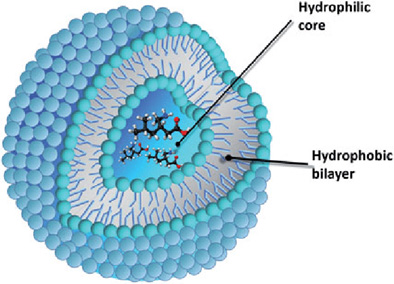
Image source. A simple liposome. Hydrophobic substances can be contained in the bilayer, hydrophilic ones in the core.
Nano-delivery occurs naturally in our bodies
Cells in the body itself utilize such a nanocarrier delivery system of particles called exosomes. Exosomes “mail” minute quantities of many important kinds of molecules to other cells in the body. “Exosomes are defined as nanometre-sized vesicles, being packages of biomolecules ranging from 40-150 nanometres in size that are released by virtually every cell type in the body. — The exosomes released by regenerative cells such as stem cells, for example, are potent drivers of healing and repair.” “Exosomes have been shown to be key mediators of cell to cell communication, delivering a distinct cargo of lipids, proteins and nucleic acids that reflects their cell of origin. — The exosomes released by regenerative cells such as stem cells, for example, are potent drivers of healing and repair. Whereas exosomes secreted from diseased cells could be used to detect and diagnose conditions such as cancers at their earliest and most readily treatable phase. — Every exosomes’ contents typically include lipids; genetic information, in the form of various types of ribonucleic acid (RNA); and proteins including enzymes, growth factors, receptors and cytokines. This cargo is contained within a phospholipid bilayer membrane, the same substance cell membranes are made from. (The same being true for liposomes) — Exosomes are found in all body fluids, and play a key role in carrying messages and molecules from one cell to another, in a target-specific manner. The recipient cell may be proximal to the sender, or at a distant site in the body(ref).”
The biomedical literature discusses the use of liposomal preparations of herbal anti-inflammatories for the treatment of rheumatoid arthritis. The following diagram is from the 2014 review article Application of Liposomes in Treatment of Rheumatoid Arthritis: Quo Vadis. It shows “Etiology of rheumatoid arthritis and potential therapeutic agents and their sites of action..” Three of the anti-inflammatory herbal ingredients shown in the diagram are the same as those in 4 Herb Synergy: boswellic acid, curcumin and withanolides .
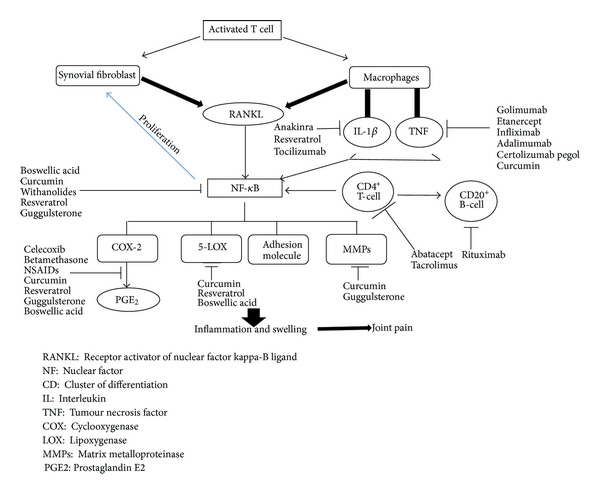
Please note the disclaimer at the end of this article. My colleagues and I make no claim that 4 Herb Synergy is effective for prevention, diagnosis or cure for arthritis or any other disease.
I celebrated my 91th birthday in November 2020 and expects to be fully active professionally at least until age 100, leading a great life. I remain in good health and remain physically and mentally active, benefiting from what I have learned about health and longevity and the longevity interventions I have been pursuing – a main one being taking 4 Herb Synergy. For more intimate detail on me, you can read some of my more-personal recent blog entries such as Funny things are happening to me on the way to 100. And UPDATE ON LONGEVITY INTERVENTIONS – MAINLY PERSONAL.’
—————————————————
MEDICAL AND PERSONAL DISCLAIMER
THE AUTHOR IS A PARTNER IN SYNERGY BIOHERBALS LLC, THE COMPANY MARKETING 4 HERB SYNERGY.
THE PURPOSE OF THIS BLOG ENTRY IS TO PRESENT GENERIC AND PERSONAL INFORMATION RELATED TO A DIETARY SUPPLEMENT RECENTLY DEVELOPED BY THE AUTHOR AND HIS COLLEAGUES. WE HEREIN WISH TO CONTINUE THE LONG-ESTABLISHED POLICY OF THIS BLOG , WHICH IS TO PRESENT ESTABLISHED SCIENTIFIC FACTS AND PERSONAL COMMENTARIES RELATED TO WELLNESS AND HEALTH, NOT TO PROVIDE MEDICAL ADVICE OR ADVOCATE ANY TREATMENT FOR CURE, PREVENTION OR DIAGNOSIS OF ANY DISEASE.
THE STATEMENTS IN THIS BLOG ENTRY HAVE NOT BEEN REVIEWED OR APPROVED BY THE FDA.
FROM TIME TO TIME, THIS BLOG MAY DISCUSS RESEARCH DEVELOPMENTS RELATING TO DISEASE PROCESSES. THE INTENTION OF THOSE DISCUSSIONS IS TO CONVEY CURRENT RESEARCH FINDINGS AND OPINIONS, NOT TO GIVE MEDICAL ADVICE. THE INFORMATION IN POSTS IN THIS BLOG IS NOT A SUBSTITUTE FOR A LICENSED PHYSICIAN’S MEDICAL ADVICE. IF ANY ADVICE, OPINIONS, OR INSTRUCTIONS HEREIN CONFLICT WITH THAT OF A TREATING LICENSED PHYSICIAN, DEFER TO THE OPINION OF THE PHYSICIAN. THIS INFORMATION IS INTENDED FOR PEOPLE IN GOOD HEALTH. IT IS THE READER’S RESPONSIBILITY TO KNOW HIS OR HER MEDICAL HISTORY AND ENSURE THAT ACTIONS OR SUPPLEMENTS HE OR SHE TAKES DO NOT CREATE AN ADVERSE REACTION.


Vince, thank you for taking the time to explain your process and motivations in producing 4 Herb Synergy Gold. Your reasoning is correct, as it is difficult for even those of us with a background in the sciences to follow the great complexity of the processes that you explore in your blog. I’ve been using your product for a year now and it does a great job of reducing sterile inflammation. I’ve seen nothing remotely comparable. Bravo!
Thanks for your feedback Stephen. Messages like this help light me up and keep me going.
Vince
Pingback: YGD YOUNGING1.0 PART 4: UNDERLYING MECHANISMS OF YOUNGING 1.0. HSC STEM CELL DIFFERENTIATION - AGINGSCIENCES™ - Anti-Aging Firewalls™AGINGSCIENCES™ – Anti-Aging Firewalls™
Pingback: Healthy, active and productive till 100. Laying out the Adult Aging Process, a Breakthrough and my Personal Story - AGINGSCIENCES™ - Anti-Aging Firewalls™